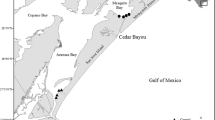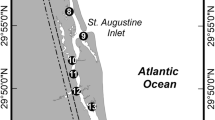Abstract
The US Army Corps of Engineers recently dredged and permanently reopened Packery Channel, historically a natural tidal inlet, to allow water exchange between the Gulf of Mexico and the Laguna Madre, TX, USA. The main objective of this study was to characterize estuarine-dependent recruitment and community structure in seagrass habitats adjacent to Packery Channel pre- and post-channel opening. We sampled fish and crustacean abundance using an epibenthic sled in Halodule wrightii seagrass meadows in both control and impact locations over 2 years, 1 year before the opening of Packery Channel (October 2004–May 2005) and 1 year after (July 2005–April 2006). Using the before–after control–impact design, we found significantly fewer nekton post-channel opening. However, we found significantly higher mean densities of newly settled estuarine-dependent species (Sciaenops ocellatus, Micropogonias undulatus, Lagodon rhomboides, Callinectes sapidus, and penaeid shrimp) post-opening. Multivariate analyses showed significant community assemblage changes post-opening with increased contribution of estuarine-dependent species post-opening. Our results show that estuarine-dependent nekton are using Packery Channel as a means of ingress into areas of the upper Laguna Madre’s seagrass meadows that were previously inaccessible, which may lead to higher fisheries productivity for some of these economically and ecologically important fishery species.




Similar content being viewed by others
References
Akin, S., K.O. Winemiller, and F.P. Gelwick. 2003. Seasonal and spatial variations in fish and macrocrustacean assemblage structure in Mad Island Marsh estuary, Texas. Estuarine Coastal and Shelf Science 57: 269–282. doi:10.1016/S0272-7714(02)00354-2.
Baltz, D.M., C. Rakocinski, and J.W. Fleeger. 1993. Microhabitat use by marsh-edge fishes in a Louisiana estuary. Environmental Biology of Fishes 36: 109–126. doi:10.1007/BF00002790.
Beck, M.W., K.L. Heck, K.W. Able, D.L. Childers, D.B. Eggleston, B.M. Gillanders, B. Halpern, C.G. Hays, K. Hoshino, T.J. Minello, R.J. Orth, P.F. Sheridan, and M.P. Weinstein. 2001. The Identification, Conservation, and Management of Estuarine and Marine Nurseries for Fish and Invertebrates. BioScience 51: 633–641. doi:10.1641/0006-3568(2001)051[0633:TICAMO]2.0.CO;2.
Blaber, S.J.M., and T.G. Blaber. 1980. Factors affecting the distribution of juvenile estuarine and inshore fish. Journal of Fish Biology 17: 143–162. doi:10.1111/j.1095-8649.1980.tb02749.x.
Blackmon, D.C., and D.B. Eggleston. 2001. Factors influencing planktonic, post-settlement dispersal of early juvenile blue crab (Callinectes sapidus Rathbun). Journal of Experimental Marine Biology and Ecology 257: 183–203. doi:10.1016/S0022-0981(00)00334-8.
Britton, J.C., and B. Morton. 1989. Shore ecology of the Gulf of Mexico, 3rd edition. Austin: University of Texas Press.
Brown, C.A., and A. Militello. 1997. Packery Channel feasibility study: bay circulation and water level. Texas A&M Research Foundation Conrad Blucher Institute for Surveying and Science, Technical Report TAMU-CC-CBI-96–07. Texas: Corpus Christi.
Brown, C.A., G.A. Jackson, S.A. Holt, and G.J. Holt. 2005. Spatial and temporal patterns in modeled particle transport to estuarine habitat with comparisons to larval fish settlement patterns. Estuarine Coastal and Shelf Science 64: 33–46. doi:10.1016/j.ecss.2005.02.004.
Bushon, A.M. 2006. Recruitment, spatial distribution, and fine-scale movement patterns of estuarine-dependent species through major and shallow passes in Texas. M.S. Thesis, Texas A&M University-Corpus Christi, Corpus Christi, Texas.
Catalán, I.A., M.T. Jiménez, J.I. Alconchel, L. Prieto, and J.L. Muñoz. 2006. Spatial and temporal changes of coastal demersal assemblages in the Gulf of Cadiz (SW Spain) in relation to environmental conditions. Deep-Sea Research II 53: 1402–1419. doi:10.1016/j.dsr2.2006.04.005.
Chambers, J.R. 1991. Coastal degradation and fish population losses. In Stemming the tide of coastal fish habitat loss, volume 14, ed. R.H. Stroud, 45–51. Savannah: National Coalition for Marine Conservation.
Clarke, K.R., and R.H. Green. 1988. Statistical design and analysis for a ‘biological effects’ study. Marine Ecology Progress Series 46: 213–226. doi:10.3354/meps046213.
Clarke, K.R., and R.M. Warwick. 2001. Change in marine communities: An approach to statistical analysis and interpretation, 2nd edition. Plymouth: PRIMER-E.
Clarke, K.R., and R.N. Gorley. 2006. PRIMER v6: User manual/tutorial. Plymouth: PRIMER-E.
Dawson Shepherd, A.R., R.M. Warwick, K.R. Clarke, and B.E. Brown. 1992. An analysis of fish community responses to coral mining in the Maldives. Environmental Biology of Fishes 33: 367–380. doi:10.1007/BF00010949.
Ditty, J.G., R.F. Shaw, and T.W. Farooqi. 2005. Sciaenidae: drums and croakers. In Early stages of Atlantic fishes: An identification guide for the western Central North Atlantic, ed. W.J. Richards, 1669–1723. Boca Raton: CRC.
Etherington, L.L., and D.B. Eggleston. 2000. Large-scale C. sapidus recruitment: linking postlarval transport, post-settlement planktonic dispersal, and multiple nursery habitats. Marine Ecology Progress Series 204: 179–198. doi:10.3354/meps204179.
Etherington, L.L., and D.B. Eggleston. 2003. Spatial dynamics of large-scale, multistage crab (Callinectes sapidus) dispersal: Determinants and consequences for recruitment. Canadian Journal of Fishes and Aquatic Sciences 60: 873–887. doi:10.1139/f03-072.
Fisher, J.A.D., and K.T. Frank. 2002. Changes in finfish community structure associated with an offshore fishery closed area on the Scotian Shelf. Marine Ecology Progress Series 240: 249–265. doi:10.3354/meps240249.
Garcia, A.M., J.P. Vieira, and K.O. Winemiller. 2001. Dynamics of the shallow-water fish assemblage of the Patos Lagoon estuary (Brazil) during cold and warm ENSO episodes. Journal of Fish Biology 59: 1218–1238. doi:10.1111/j.1095-8649.2001.tb00187.x.
Greenstreet, S.P.R., and S.J. Hall. 1996. Fishing and the ground-fish assemblage structure in the north-western North Sea: An analysis of long-term and spatial trends. Journal of Animal Ecology 65: 577–598. doi:10.2307/5738.
Griffiths, S.P. 2001. Recruitment and growth of juvenile yellow bream, Acanthopagrus australis Günther (Sparidae), in an Australian intermittently open estuary. Journal of Applied Ichthyology 17: 240–243. doi:10.1046/j.1439-0426.2001.00288.x.
Griffiths, S.P., and R.J. West. 1999. Preliminary assessment of shallow water fish in three small intermittently open estuaries in south-eastern Australia. Fisheries Management and Ecology 6: 311–321.
Heck, K.L., G. Hays, and R.J. Orth. 2003. Critical evaluation of the nursery role hypothesis for seagrass meadows. Marine Ecology Progress Series 253: 123–136. doi:10.3354/meps253123.
Hoff, J.G., and R.M. Ibara. 1977. Factors affecting the seasonal abundance, composition and diversity of fishes in a southeastern New England Estuary. Estuarine Coastal and Marine Science 5: 665–678. doi:10.1016/0302-3524(77)90091-3.
Holt, S.A., C.L. Kitting, and C.R. Arnold. 1983. Distribution of young S. ocellatus among different sea-grass meadows. Transactions of the American Fisheries Society 112: 267–271. doi:10.1577/1548-8659(1983)112<267:DOYRDA>2.0.CO;2.
Javor, B. 1989. Hypersaline environments, 1st edition. New York: Springer.
Jones, M.V., and R.J. West. 2005. Spatial and temporal variability of seagrass fishes in intermittently closed and open coastal lakes in southeastern Australia. Estuarine, Coastal, and Shelf Science 64: 277–288. doi:10.1016/j.ecss.2005.02.021.
Keough, M.J., and B.D. Mapstone. 1997. Designing environmental monitoring for pulp mills in Australia. Water Science and Technology 35: 397–404. doi:10.1016/S0273-1223(96)00955-9.
Kneib, R.T. 1993. Growth and mortality in successive cohorts of fish larvae within an estuarine nursery. Marine Ecology Progress Series 94: 115–127. doi:10.3354/meps094115.
Kneib, R.T., and S.L. Wagner. 1994. Nekton use of vegetated marsh habitats at different stages of tidal inundation. Marine Ecology Progress Series 106: 227–238. doi:10.3354/meps106227.
Levin, P., R. Petrik, and J. Malone. 1997. Interactive effects of habitat selection, food supply, and predation on recruitment of an estuarine fish. Oecologia 112: 55–63. doi:10.1007/s004420050283.
Loneragan, N.R., I.C. Potter, R.C.J. Lenanton, and N. Caputi. 1986. Spatial and seasonal differences in the fish fauna in the shallows of a large Australian estuary. Marine Biology 92: 575–586. doi:10.1007/BF00392517.
Loneragan, N.R., I.C. Potter, R.C.J. Lenanton, and N. Caputi. 1987. Influence of environmental variables on the fish fauna of the deeper waters of a large Australian estuary. Marine Biology 94: 631–641. doi:10.1007/BF00431410.
Ludwig, J.A., and J.F. Reynolds. 1988. Statistical ecology. A primer on methods and computing. New York: Wiley.
McKee, D.M. 2008. Fishes of the Texas Laguna Madre, 1st edition. College Station: Texas A&M University Press.
Minello, T.J. 1999. Nekton densities in shallow estuarine habitats of Texas and Louisiana and the identification of essential fish habitat. American Fisheries Society Symposium 22: 43–75.
Montagna, P.A., and C. Ritter. 2006. Direct and indirect effects of hypoxia on benthos in Corpus Christi Bay, Texas U.S.A. Journal of Experimental Marine Biology and Ecology 330: 119–131. doi:10.1016/j.jembe.2005.12.021.
Morgan, M.D. 1980. Grazing and predation of the grass shrimp. Palaemonetes pugio. Limnology and Oceanography 25: 896–902.
Moser, M.L., and L.R. Gerry. 1989. Differential effects of salinity changes on two estuarine fishes, Leiostomus xanthurus and Micropogonias undulatus. Estuaries 12: 35–41. doi:10.2307/1351448.
Orth, R.J., K.L. Heck Jr., and J. van Montfrans. 1984. Faunal communities in seagrass beds: A review of the influence of plant structure and prey characteristics on predator-prey relationship. Estuaries 7: 339–350. doi:10.2307/1351618.
Patillo, M.E., T.E. Czapla, D.M. Nelson, and M.E. Monaco. 1997. Distribution and abundance of fishes and invertebrates in Gulf of Mexico Estuaries Volume II: Species life history summaries. Silver Spring: National Oceanic and Atmospheric Administration/National Ocean Service Strategic Environmental Assessments DivisionEstuarine living marine resources program Report No. 11.
Petrik, R., P.S. Levin, G.W. Stunz, and J. Malone. 1999. Recruitment of M. undulatus, Micropogonias undulatus: Do postsettlement processes disrupt or reinforce initial patterns of settlement? Fishery Bulletin 97: 954–961.
Pile, A.J., R.N. Lipcius, J. Van Montfrans, and R.J. Orth. 1996. Density-dependent settler-recruit-juvenile relationships in C. sapidus. Ecological Monographs 66: 277–300. doi:10.2307/2963519.
Poling, K.R., and L.A. Fuiman. 1999. Behavioral specialization in developing sciaenids and its relationship to morphology and habitat. Environmental Biology of Fishes 54: 119–133. doi:10.1023/A:1007575023588.
Quammen, M.L., and C.P. Onuf. 1993. Laguna Madre—Seagrass changes continue decades after salinity reduction. Estuaries 16: 302–310. doi:10.2307/1352503.
Reid, G.K. 1957. Biologic and hydrographic adjustment in a disturbed Gulf Coast estuary. Limnology and Oceanography 2: 198–212.
Rooker, J.R., and G.J. Holt. 1997. Utilization of subtropical seagrass meadows by newly settled S. ocellatus Sciaenops ocellatus: patterns of distribution and growth. Marine Ecology Progress Series 158: 139–149. doi:10.3354/meps158139.
Rozas, L.P., and C.T. Hackney. 1984. Use of oligohaline marshes by fishes and macrofaunal crustaceans in North Carolina. Estuaries 7: 213–224. doi:10.2307/1352141.
Rozas, L.P., and T.J. Minello. 1998. Nekton use of salt marsh, seagrass, and nonvegetated habitats in a south Texas (USA) estuary. Bulletin of Marine Science 63: 481–501.
Sheridan, P. 2004. Comparison of restored and natural seagrass beds near Corpus Christi, Texas. Estuaries 27: 781–792.
Simmons, E.G., and H.D. Hoese. 1959. Studies on the hydrography and fish migrations of cedar bayou, a natural tidal inlet on the central Texas coast. Institute of Marine Science University of Texas 6: 56–80.
Stewart-Oaten, A., and W.W. Murdoch. 1986. Environmental impact assessment: “pseudoreplication in time? Ecology 67: 929–940. doi:10.2307/1939815.
Stunz, G.W., T.J. Minello, and P.S. Levin. 2002. A comparison of early juvenile S. ocellatus densities among various habitat types in Galveston Bay, Texas. Estuaries 25: 76–85.
Tunnell, J.W. Jr., N.L. Hilburn, and K. Withers. 2002. Comprehensive bibliography of the Laguna Madre of Texas and Tamaulipas, 1st edition. Corpus Christi: Center for Coastal Studies Texas A&M University-Corpus Christi.
Unites States Army Corps of Engineers. 2003. North Padre Island storm damage reduction and environmental restoration project. Galveston: United States Army Corps of EngineersFinal Environmental Impact Statement.
Weinstein, M.P. 1979. Shallow marsh habitats as primary nurseries for fishes and shellfish, Cape Fear River, North Carolina. Fishery Bulletin 77: 339–357.
Weinstein, M.P., S.L. Weiss, and M.F. Walters. 1980. Multiple determinants of community structure in shallow marsh habitats, Cape Fear river estuary, North Carolina, USA. Marine Biology 58: 227–243. doi:10.1007/BF00391880.
Young, G.C., and I.C. Potter. 2003. Influence of an artificial entrance channel on the ichthyofauna of a large estuary. Marine Biology 142: 1181–1194.
Zein-Eldin, Z.P., and M.L. Renaud. 1986. Inshore environmental effects on brown shrimp, Penaeus aztecus, and white shrimp, P. setiferus, populations in coastal waters, particularly of Texas. Marine Fisheries Review 48: 9–19.
Acknowledgements
We would like to thank the Coastal Bend Bays and Estuaries Program, Texas A and M University - Corpus Christi (TAMU-CC), NOAA Sea Grant #NA06OAR4170076, and the Coastal Conservation Association for funding this research. We thank Dr. Paul Montagna, Terry Palmer, Dr. Kim Withers, and John Froeschke for their assistance with the analysis. We also thank Deidre Williams and Lanmon Aerial Photography, Inc. for providing aerial photography. This project would not have been possible without the members of the Fisheries Ecology Lab at TAMU-CC and their numerous hours of field and laboratory help. We particularly would like to thank Sarah Bayer, Heather Barackman, Annette Cardona, Rafael Calderon, Alyssa Dailey, Ryan Fikes, Todd Neahr, and Brooke Stanford.
Author information
Authors and Affiliations
Corresponding author
Rights and permissions
About this article
Cite this article
Reese, M.M., Stunz, G.W. & Bushon, A.M. Recruitment of Estuarine-Dependent Nekton Through a New Tidal Inlet: the Opening of Packery Channel in Corpus Christi, TX, USA. Estuaries and Coasts 31, 1143–1157 (2008). https://doi.org/10.1007/s12237-008-9096-x
Received:
Revised:
Accepted:
Published:
Issue Date:
DOI: https://doi.org/10.1007/s12237-008-9096-x




